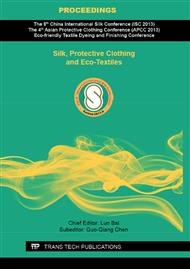p.21
p.25
p.36
p.39
p.43
p.48
p.57
p.62
p.67
Growth of Hydroxyapatite Crystals on Bombyx mori (B. mori) Silk Fibroin
Abstract:
As a natural protein polymer, Bombyx mori silk fibroin (SF) has superior characteristics such as excellent mechanical properties, biocompatibility and biodegradation which make SF to be a potential candidate in the field of biomaterials. It has been reported that the mineralized SF can be used for bone repair and regeneration in the bone tissue engineering. In order to map out the growth process of hydroxyapatite (HAp) induced by SF in the mineralized buffer solution, the co-solution of SF and supersaturated simulated body fluid (1.5 SBF) was incubated at 37.2 °C for 7 days and observed by using TEM, DSC, DTA and TGA in this study. The TEM results indicated that nanoscale crystal nuclei were found along the surface of SF in the initial stage of mineralization and finally these crystals aggregated into three-dimensional network. DSC and DTA results showed that the thermal stability of HAp/SF was greatly improved by increasing incubation duration and that the phase transition of HAp occurred from metastable state to steady state. TGA results suggested the organic content of HAp/SF complex was about 21% which was similar to the natural bone.
Info:
Periodical:
Pages:
43-47
Citation:
Online since:
September 2013
Authors:
Keywords:
Price:
Сopyright:
© 2013 Trans Tech Publications Ltd. All Rights Reserved
Share:
Citation:


